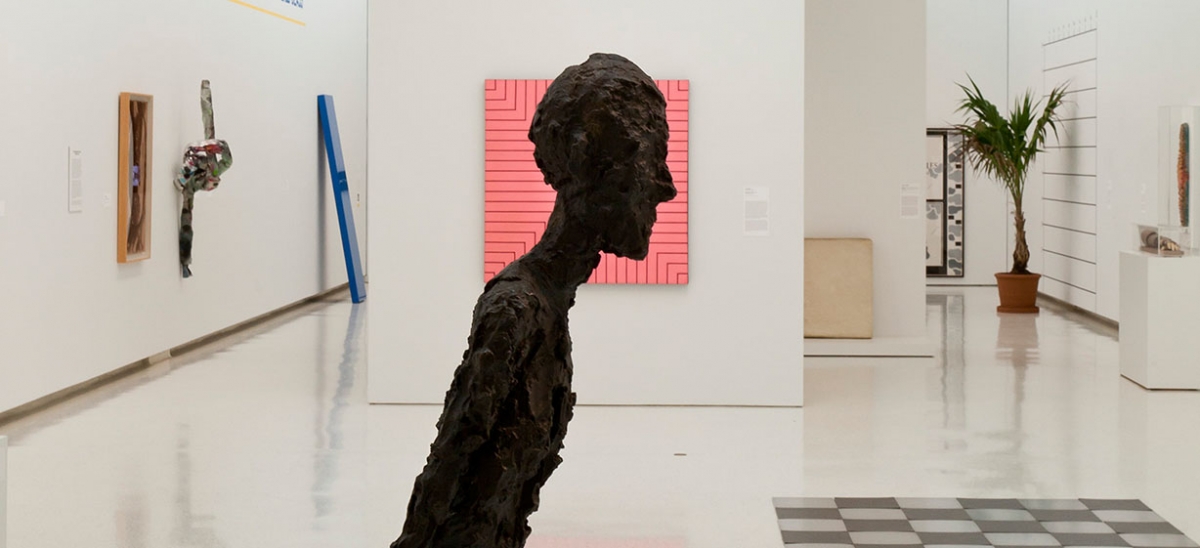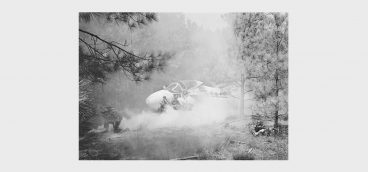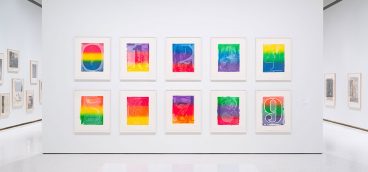
A useful trick for carnegie museum of Art visitors is to read the label on the wall beside the art. In the lower corner is the accession number, for example, 96.1, which indicates the year in which the work was acquired, 1896, followed by the order in which the work was entered into the museum’s ledgers in that same year, .1. In fact, this number refers to Winslow Homer’s “The Wreck,” painted in 1896, which was the first painting the museum acquired. That painting also happens to have been in the first Carnegie International Exhibition, so today that painting bears an additional bright red label attesting to that fact. Works exhibited in later Internationals are similarly noted with red labels, until 1943, when, for some reason, yellow labels are used.
These facts matter more in 2013 because this is not only an International year (Oct. 5, 2013–March 16, 2014), but also the first time that the permanent collection marks its indebtedness to previous Internationals with a thorough-going re-hang of the collection. In a time dominated by dealer-led exhibitions (Maastricht, Basel, Frieze London, Frieze New York, Hong Kong, Miami and other such shows that survive as long as the dealers find them profitable) and established biennial-type shows (Venice, Documenta, Istanbul), the Carnegie Museum is the only institution that can point to a permanent collection informed and aggregated by past exhibitions. This museum is the only mother suckled by its baby.
To press the issue further, the modern and contemporary sections of the permanent collections, now re-hung and re-thought, have been preserved for the run of the International more or less intact. They have not been relegated to the storerooms in the basement. (I think this is without precedent.) Visitors whose interest is mainly in the contemporary can now judge the strengths and weaknesses of what The Carnegie now has, and, just as important, deduce what The Carnegie thinks of itself.
Not for the first time, the International has seen fit to wander all over the campus of the Institute, challenging and celebrating it. For the last few months, changes are in evidence anticipating a radical International. Perhaps the most obvious and symbolic may be seen outside of the museum in the form of Yvan Pestalozzi’s 1972 “Lozziwurm.” This colorful worm-like piece, in effect a children’s playground, invokes the spirit of play as a theme in the forthcoming International. But, in keeping with the nature of worms, it has munched its way through another artwork, Daniel Urban Kiley’s 1974 landscape for the surrounds of the Scaife Wing, which was intended to harmonize the modern part of the museum with the familiar old Beaux-Arts Carnegie Institute. The aim of the Lozziwurm is to bring the child into the discourse of contemporary art.
This modern and contemporary re-hang is the work of the curator of contemporary art, Dan Byers, and one of his co-curators of the International, Tina Kukielski. But Museum Director Lynn Zelevansky and the other co-curator of the International, Daniel Baumann, have their own considered inputs. In June, as I walked through the installations of this year with Byers, it became clear that this is a complex field. The museum’s conservation department has a definite voice in these deliberations. When Byers succeeded in having Alberto Giacometti’s bronze “Walking Man,” 1960, placed on the floor without its protective plinth, the department demanded safeguards (another example from this edition of the work has sold for $103 million!). On the other hand, Carl Andre’s once-controversial “Aluminum-Lead Plain,” 1969, a supremely flat sculpture the artist intended the visitor to walk upon, remains unaffected by the department. The somewhat phallic Yayoi Kusama wall sculpture is now placed behind glass. (Byers, somewhat ruefully, suggests that is “the right decision,” ignoring the Franz Erhard Walther, “Projection Sculpture,” 1962, propped nonchalantly behind him).
In the gallery spaces, there has been relatively little intervention. The long, top-lit galleries that most typify the Scaife Wing each have been interrupted with two wall-baffles that make a small walk-through room in the middle, where, for example, you will encounter the Paul Thek and the Franz Erhard Walther on a more intimate footing. The walls are brilliant white,which are safe, no-risk and nearly always work. Take note of a good Arthur Dove, “Tar Barrels, Huntington Harbor,” 1930, given in 1953 by G. David Thompson; it’s now cleaned of its nicotine but still looks filthy in its old but not original frame, which the white walls emphasize. Byers hopes to reframe it soon.
The earlier moderns have been interestingly subdivided. On one wall is the circle of artists associated with Alfred Stieglitz: Dove, Marsden Hartley and Georgia O’Keeffe. On the other is a more heterogeneous mixture of regionalism, realism, etc., including Robert Gwathmey, Henry Koerner and Romare Bearden. Abstraction fills the high east section of this gallery, probably enforced by the size of the big Stuart Davis. Note the yellow labels on the Ellsworth Kelly “Aubade,” 1957, and Myron Stout’s “Untitled (No. 3),” 1956, both shown in the 1958 International. That International is highly rated by many critics. One day, let it be hoped, the curators will have the courage to repaint Isamu Noguchi’s “Structure,” 1945, shown in the same space. This well-known and much loved work was stripped arbitrarily of its paint by the then-owner, G. David Thompson, (to Noguchi’s ire) before it was donated to the museum. In the east end of this same gallery, there is a fairly radical change of pace, in that photography and works on paper make an appearance (notice how the light levels are controlled at a lower level to protect the works). The Charles Burchfields, of which the museum has quite a number, will have to be rotated systematically.
It’s worth mentioning here the role of the patron-collector in the building up of this collection. The Burchfields (and the Doves) were the gift of Mr. and Mrs. James H. Beal (Mrs. Beal had the more muscular eye). With G. David Thompson and Mrs. Alan Scaife, the collections have been greatly enriched. (It is probably inappropriate and invidious to mention living collectors who have enriched the collection while they are still alive.) In the area showing photography, note the wry juxtaposition of two photographs of formidable women (“Jane Heap” and “War Mother II”) by Berenice Abbott and Luke Swank, respectively.
Also at the west end of the modern and contemporary spaces, the museum has created a space for photography, film and video. One section will be used for the International. (At the time of writing, it was used to show newly acquired photographic works and works of paper.)
The re-hang of the last few galleries (still quite a stretch) is perhaps a little perilous for a new curator, since most of the curators and directors since 1982 are still alive and kicking and can still be encountered on the museum and lecture circuit. Byers and Kukielski have decided to do away with quite a few totemic works, sending them to the basement. Most significant is Anselm Kiefer’s “Midgard,” 1980-85, which at nearly 12 by 20 feet was clearly noticeable in its absence. The works of the COBRA artists are no longer to be seen, and the currently magic names of Andy Warhol, Francis Bacon and Lucien Freud are experiencing banishment. Perhaps this is what the stock market calls a “correction.”
Of the rest there seems to be a different sensibility, which has selectively retained what interests the current curators. It is lighter and rather more combative. Serious issues are often taken ironically. Peter Saul’s “Mr. Welfare,” 1969, even in the label described as “absurdly offensive,” is hung with a vivid neon piece by Bruce Nauman and Ed Paschke’s “Kevin,” 1976. These three works seem to cry “Goodbye Mr Chips” to the staid Jackson Pollock accidentally in our sight lines. The Pollock, incidentally, has been condemned to gaze on Frank Stella’s “Delaware Crossing,” 1967, in its bubblegum pink glory.
The last few spaces of the contemporary section usually are given to the latest works acquired for the collection, in the large boxy galleries, and are usually presented with major significant work from the collection. This area is almost always understood as where the curator of the day “does his thing.” Here, the grimness of the Louise Bourgeois “Cell” (a “welcome” reappearance), and the terrifying solidity of the Doris Salcedo “Untitled (armoire),” 1992, are culled from past Internationals. Byers continues the anxious theme, successively passing from Cathy Wilkes’s recent installation in the museum’s Forum Gallery (re-installed here) to the edgy and fragile installation by Karen Kilimnik. All these are sweetened a little by the Fischl/Weiss/ Archangel video works, the Paul Chan video, and even the Chris Ofili, “The Adoration of Captain Shit and the Legend of the Black Stars (3rd version),” 1999. But perhaps not much. These juxtapositions and shifting moods put me in mind of one of Byers’s early exhibitions at The Carnegie, when again he entered the black hole of the reserve collection to bring forth work for reconsideration. That show was called “Ordinary Madness,” and presented works in a kind of jangling dialogue with each other. This is a condition to which we may have to become accustomed. As a postscript, may I appeal to the museum to make provision to show the reserve collection on a continuing basis to the general public, as is the practice in a number of museums. The National Gallery in London shows all of its showable paintings in a well-lit but basic gallery and it is accessible at all times. It allows the public to test the eye of the museum, which is no bad thing.





